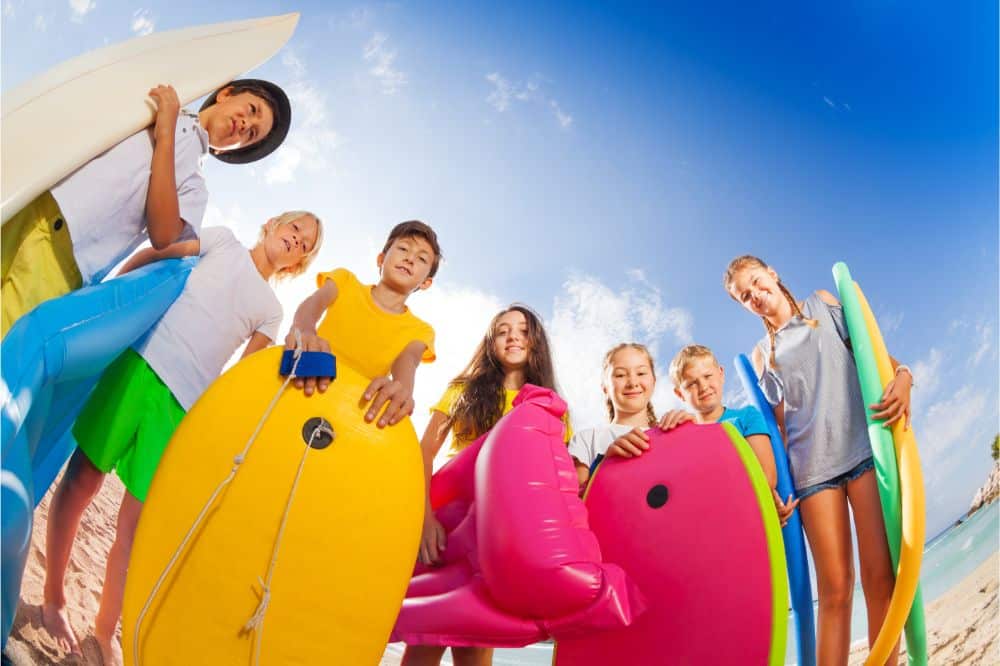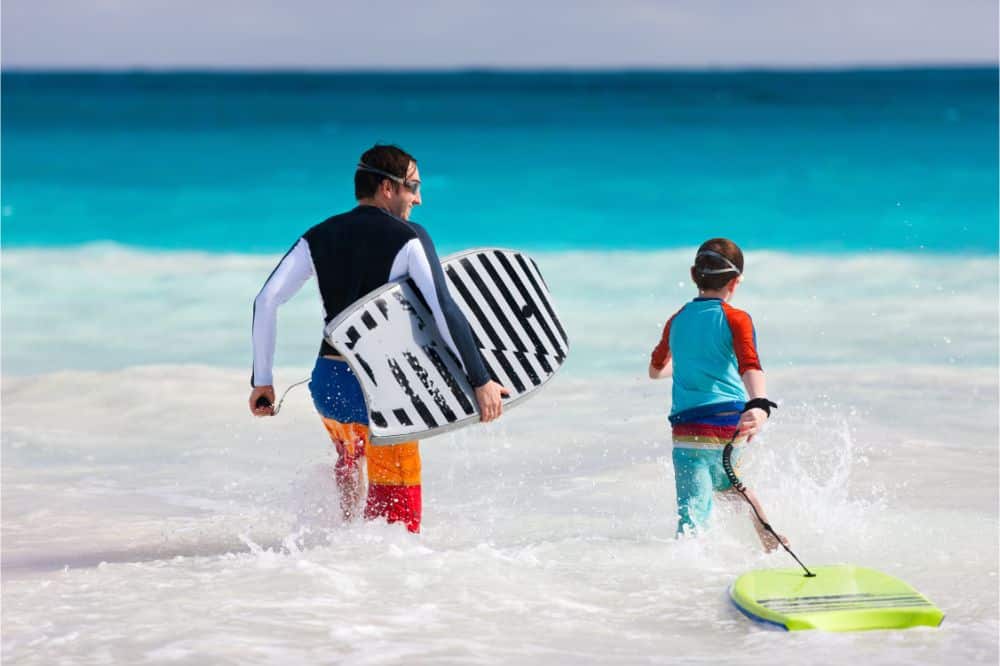Bodyboarding is a great way to get your kids out of the house, into the great outdoors, and experience something adventurous. Whether you’re a seasoned bodyboarder or a beginner, learning how to safely and enjoyably bodyboard with kids is a rewarding experience and additionally a great and healthy exercise for the little ones.
To make it more enjoyable for everybody at the beginning, we’ve set up this Bodyboarding with Kids Made Easy Guide. So in this article, we’ll look at pre-trip safety considerations, choosing the right board, teaching bodyboarding techniques, finding the right beach, and making it fun for everyone.

Pre-Trip Considerations
When considering safety for bodyboarding with kids, check into the local beach regulations and risk assessments for the area you plan to visit. Be sure that the bodyboard of the child is equipped with a wrist leash.
Check for the actual water temperatures of the beach you’re planning to visit (more on how to find the right beach can be found here). In short, the most important features a good beach for kids should have are:
- Sand beach
- Should have shallow areas in which the kids can stand by themselves and have broken waves in these areas which are running out
- Beach without strong currents
Besides the board, check if you have all the additional equipment you may need, depending on the area, size, and skill of your kid. These are:
- Rash guard or wetsuit which fits
- Life vest for small kids or kids who cannot swim
- Fins for kids with advanced bodyboarding skills
- Water-resistant sunscreen
- Water shoes if you plan not to visit a sandy beach
- Something to drink and to eat
- A small, basic medic kit with ointment and water-resistant pavement for small scratches
Safety Considerations
When it comes to bodyboarding with kids, safety is always the number one priority. There are certain aspects you have to consider regarding the beach you choose, the equipment, and your personal role as an adult.
Beach
It’s important to make sure that the beach you choose has a shallow water area for your little ones to bodyboard in, especially beginner and younger kids, who need an area where they can stand themselves and which has broken waves to start bodyboarding. You should also choose a beach with a range of wave approaches, from deep water to shallow water so that your child can gradually progress as they become familiar with the basics of wave riding.
Additionally, look for beginner-friendly waves that won’t overwhelm your kids with too much intensity.
Check for information about the currents in the area. Of course, as soon as you have some waves there will always be some currents. However, make sure that you do not choose a beach that is known to have especially high and strong currents.
Finally, look for a beach that is sandy and does not have rocks in the area you’re surfing with your kids.
Equipment
Buy a good-quality kid’s bodyboard in the correct size so that the child gets enough buoyancy from the board.
Also, make sure that the board has a good wrist leash and that it is always properly tightened when the child is in the water.
Finally, it is important that the correct bodyboard clothing is worn, especially in relation to the water and air temperature. On the one hand, this protects against hypothermia, but also against annoying and painful abrasions on the belly and chest of the little ones.
Additional tip: If there is no suitable sandy beach in your vicinity, but a pebble beach, a pair of water shoes will help to make walking and moving on the beach and in the water easier.
Your personal role
The most important thing is that the children are always accompanied by an adult. It must never be underestimated how quickly children can be lifted off the waves and how strong the pull of the returning water can be. So it happens faster than you think that the child gets a little further out into an area where they can no longer stand.
Therefore, accompany the child to the area where they enter the wave with the bodyboard (this is necessary either way at the beginning learn bodyboarding). This way, you can always help the child stay in the safe area of the beach.
Choosing The Right Board
When it comes to choosing the right board, it’s important to take into account the size, weight, and material of the board. A good bodyboard for kids should have lightweight, but also durable and flexible. Ideally, the board should be made from a material that is designed to withstand the elements. You can find boards made from different materials such as foam, plastic, epoxy, and fiberglass.
Personally, we believe that a good quality EPS board is absolutely sufficient, especially at the beginning.
More expensive PE or PP boards with stringers etc. only come into question when an advanced level is reached.
Much more important at the beginning is that the size is chosen correctly; the goal is to be able to celebrate success as quickly as possible in order to keep the fun factor as high as possible.
A board that is too small offers too little buoyancy and makes it more difficult to catch a wave and get into the actual surfing. Conversely, a board that is too big is harder to hold, and control, and gets in the way when paddling with your feet.
By the way, you can find a corresponding size chart for kids here. In the same article, we have also compiled a list of boards that, in our experience, are well suited for children and do not cost the earth.

Teaching bodyboarding Technique
But how to start bodyboarding now?
Basically, I suggest that you do it in three phases. In my personal experience: if you follow them, you’ll be astonished at how fast and easily the kids will learn bodyboarding.
Phase 1
Start with the child in shallow water, where the waves are already broken. Ideally, when there are no waves, the water in this area is about hip-deep to maximum chest-deep (of the child).
In the first phase, the child should then be in the bodyboard position, that is, lying on his belly on the board. The hands are both in the front area on the board. As an adult, you can then hold the child by the legs, align them accordingly and, when the wave comes, give thrust. This trains or enables the following things:
– The child learns the timing, when it needs propulsion to reach a wave.
– The child quickly has a sense of achievement and can experience the incredible feeling of surfing
Phase 2
In the second phase, i.e. after a few successful wave rides, you can move on to letting the little ones get into the waves themselves. It is important to start again in shallow water. This makes it possible that the child does not have to reach the wave by paddling alone, but can “jump” into the wave, so to speak.
This phase especially trains the timing of the waves and when it takes propulsion to be able to surf a wave. So they learn how the entry actually works, which is the most difficult part to learn for real bodyboarding in deeper water and higher waves.
Phase 3
Once they feel comfortable on the board in the shallow water, you can start to move more and more into the area where the waves have not yet broken. But this also means that the water becomes correspondingly deeper and the “standing area” is left.
From my point of view, especially children must be accompanied here further so that one can help as quickly as possible. Ideally, you are there as an adult with a bodyboard or even with a surfboard, so that you can concentrate on the child and help at any time. In addition, depending on how good a swimmer the kids are, you should definitely consider a thin life jacket (which is less disturbing when bodyboarding) or a wetsuit (wetsuits provide an amazing amount of buoyancy).
At this stage, it is important to help the child find the right timing for entry. Besides timing, the most difficult thing for children is to develop enough propulsion for entry. So if the children are already so advanced, it definitely makes sense to purchase suitable fins
Finding The Right Beach
When it comes to finding the right beach for bodyboarding with kids, safety should be the priority. Look for a beach that is suitable for the age range and experience level of your kids. Look for beaches with shallow water and plenty of room for them to move around and get comfortable with the basics of wave riding. Make sure the beach has beginner-friendly waves and no strong currents. Typically, these are beaches that slope more shallowly, creating a larger area with less deep water.
Bodyboarding with Kids Made Easy
– It is a sandy beach
– The water is not too cold
– The beach is wide so that the children can still pursue other activities and games.
– There is an area on the beach that is as sheltered from the wind as possible, because strong winds on the beach, which are often needed for waves, can be unpleasant.
Examples of beaches that we find super, almost perfect for bodyboarding with children are:
– Playa del Castillo near El Cotillo on Fuerteventura
– North Coronado Beach near San Diego
These beaches, but of course many others in this beautiful world, fulfill from my point of view more or less everything you need for a great day with kids.
Making it fun
Making it fun is key when bodyboarding with kids.
The most important thing is to make sure that:
- Motivation is kept high: the best way to do this is through a sense of achievement;
- Any fear of the sea or the waves is taken away: the best way to do this is to enter slowly and carefully and to always accompany the child while bodyboarding;
- No pressure is built up: if there is no desire to go into the water or the child simply wants to play in the waves, just let it happen;
- Provide variety: take other things to the beach, such as a ball, kite, or skimboard.
As said above, the most important cornerstone for fun and motivation in children is how quickly and easily they feel a sense of achievement. From my experience, the best approach is to slowly introduce your child to bodyboarding in the three phases we presented.
In any case, this worked out very well for my boys. At least, they are still into bodyboarding today and beam every time they come out of the water.
Conclusion
Bodyboarding with kids is a fantastic outdoor activity that is not only fun but also great exercise. With the right safety considerations, suitable boards, and a beginner-friendly beach, there’s no reason why kids can’t have a blast with bodyboarding.
Teaching your kids the basics of wave riding is an important step in helping them get the most out of the activity.
Remember to stick to shallow water and broken waves until your kids have developed their skills, and to use the tips we’ve given to ensure their safety. Once they’ve grasped the basics, you can move on to more challenging waves and activities. With a wide range of boards, sizes, and safety equipment available, bodyboarding with kids is a great way to enjoy the beach.






